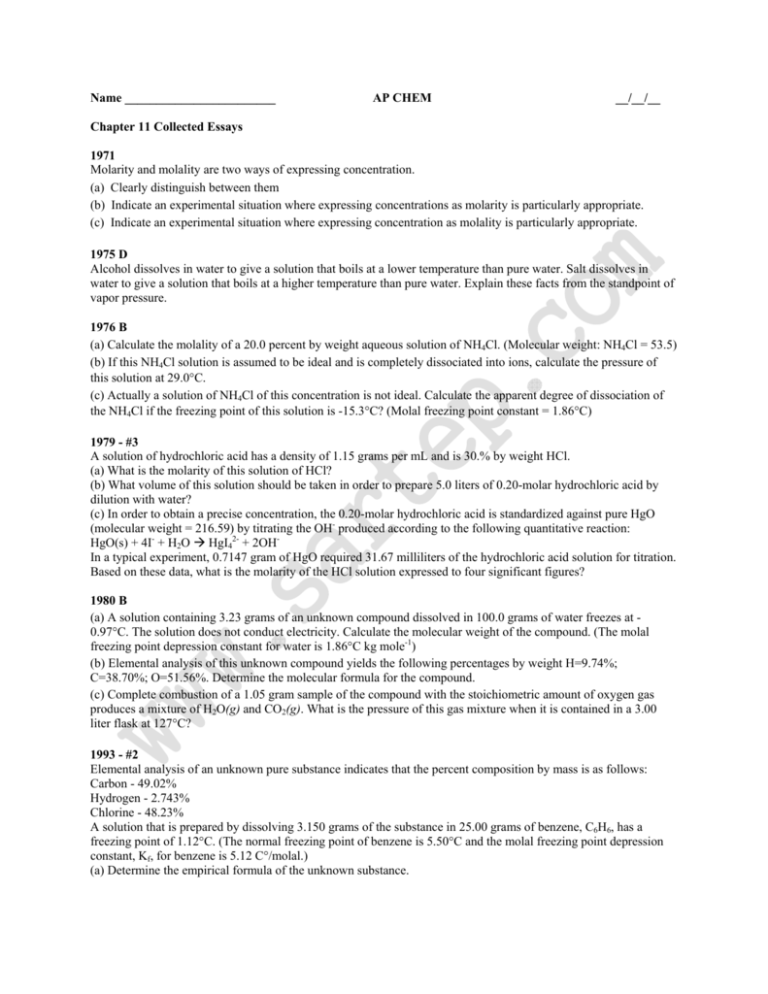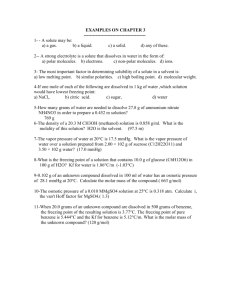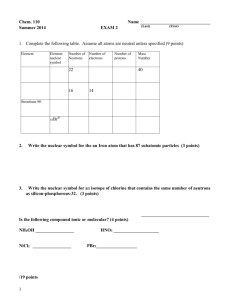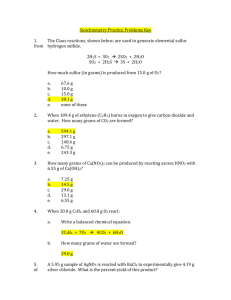AP CHEM __/__/__ Chapter 11 Collected Essays 1971
advertisement

Name ________________________ AP CHEM __/__/__ Chapter 11 Collected Essays 1971 Molarity and molality are two ways of expressing concentration. (a) Clearly distinguish between them (b) Indicate an experimental situation where expressing concentrations as molarity is particularly appropriate. (c) Indicate an experimental situation where expressing concentration as molality is particularly appropriate. 1975 D Alcohol dissolves in water to give a solution that boils at a lower temperature than pure water. Salt dissolves in water to give a solution that boils at a higher temperature than pure water. Explain these facts from the standpoint of vapor pressure. 1976 B (a) Calculate the molality of a 20.0 percent by weight aqueous solution of NH4Cl. (Molecular weight: NH4Cl = 53.5) (b) If this NH4Cl solution is assumed to be ideal and is completely dissociated into ions, calculate the pressure of this solution at 29.0C. (c) Actually a solution of NH4Cl of this concentration is not ideal. Calculate the apparent degree of dissociation of the NH4Cl if the freezing point of this solution is -15.3C? (Molal freezing point constant = 1.86C) 1979 - #3 A solution of hydrochloric acid has a density of 1.15 grams per mL and is 30.% by weight HCl. (a) What is the molarity of this solution of HCl? (b) What volume of this solution should be taken in order to prepare 5.0 liters of 0.20-molar hydrochloric acid by dilution with water? (c) In order to obtain a precise concentration, the 0.20-molar hydrochloric acid is standardized against pure HgO (molecular weight = 216.59) by titrating the OH- produced according to the following quantitative reaction: HgO(s) + 4I- + H2O HgI42- + 2OHIn a typical experiment, 0.7147 gram of HgO required 31.67 milliliters of the hydrochloric acid solution for titration. Based on these data, what is the molarity of the HCl solution expressed to four significant figures? 1980 B (a) A solution containing 3.23 grams of an unknown compound dissolved in 100.0 grams of water freezes at 0.97°C. The solution does not conduct electricity. Calculate the molecular weight of the compound. (The molal freezing point depression constant for water is 1.86°C kg mole-1) (b) Elemental analysis of this unknown compound yields the following percentages by weight H=9.74%; C=38.70%; O=51.56%. Determine the molecular formula for the compound. (c) Complete combustion of a 1.05 gram sample of the compound with the stoichiometric amount of oxygen gas produces a mixture of H2O(g) and CO2(g). What is the pressure of this gas mixture when it is contained in a 3.00 liter flask at 127°C? 1993 - #2 Elemental analysis of an unknown pure substance indicates that the percent composition by mass is as follows: Carbon - 49.02% Hydrogen - 2.743% Chlorine - 48.23% A solution that is prepared by dissolving 3.150 grams of the substance in 25.00 grams of benzene, C6H6, has a freezing point of 1.12°C. (The normal freezing point of benzene is 5.50°C and the molal freezing point depression constant, Kf, for benzene is 5.12 C°/molal.) (a) Determine the empirical formula of the unknown substance. (b) Using the data gathered from the freezing point depression method, calculate the molar mass of the unknown substance. (c) Calculate the mole fraction of benzene in the solution described above. (d) The vapor pressure of pure benzene at 35°C is 150. millimeters of Hg. Calculate the vapor pressure of benzene over the solution described above at 35°C. 1996 - #4 Concentrated sulfuric acid (18.4-molar H2SO4) has a density of 1.84 grams per milliliter. After dilution with water to 5.20-molar, the solution has a density of 1.38 grams per milliliter and can be used as an electrolyte in lead storage batteries for automobiles. (a) Calculate the volume of concentrated acid required to prepare 1.00 liter of 5.20-molar H2SO4. (b) Determine the mass percent of H2SO4 in the original concentrated solution. (c) Calculate the volume of 5.20-molar H2SO4 that can be completely neutralized with 10.5 grams of sodium bicarbonate NaHCO3. (d) What is the molality of the 5.20-molar H2SO4? 1998 - #2 An unknown compound contains only the three elements C,H, and O. A pure sample of the compound is analyzed and found to be 65.60 percent C and 9.44 percent H by mass. (a) Determine the empirical formula of the compound. (b) A solution of 1.570 grams of the compound in 16.08 grams of camphor is observed to freeze at a temperature 15.2 Celsius degrees below the normal freezing point of pure camphor. Determine the molar mass and apparent molecular formula of the compound. (The molal freezing-point depression constant, Kf, for camphor is 40.0 kg-Kmol-1.) (c) When 1.570 grams of the compound is vaporized at 300 °C and 1.00 atmosphere, the gas occupies a volume of 577 milliliters. What is the molar mass of the compound based on this result? (d) Briefly describe what occurs in solution that accounts for the difference between the results obtained in parts (b) and (c). 1999 - #7 Answer the following questions, which refer to the 100 mL samples of aqueous solutions at 25°C in the closed flasks shown below. a. b. c. d. Which solution has the lowest electrical conductivity? Explain. Which solution has the lowest freezing point? Explain. Above which solution is the pressure of water vapor greatest? Explain. Which solution has the highest pH? Explain. 2000 - #5 The molar mass of an unknown solid, which is nonvolatile and a nonelectrolyte, is to be determined by the freezingpoint depression method. The pure solvent used in the experiment freezes at 10°C and has a known molal freezingpoint depression constant, Kf . Assume that the following materials are also available. test tubes stirrer pipet thermometer balance beaker stopwatch graph paper hot-water bath ice (a) Using the two sets of axes provided below, sketch cooling curves for (i) the pure solvent and for (ii) the solution as each is cooled from 20°C to 0.0°C. (b) Information from these graphs may be used to determine the molar mass of the unknown solid. (i) Describe the measurements that must be made to determine the molar mass of the unknown solid by this method. (ii) Show the setup(s) for the calculation(s) that must be performed to determine the molar mass of the unknown solid from the experimental data. (iii) Explain how the difference(s) between the two graphs in part (a) can be used to obtain information needed to calculate the molar mass of the unknown solid. (c) Suppose that during the experiment a significant but unknown amount of solvent evaporates from the test tube. What effect would this have on the calculated value of the molar mass of the solid (i.e., too large, too small, or no effect)? Justify your answer. (d) Show the setup for the calculation of the percentage error in a student’s result if the student obtains a value of 126 g mol−1 for the molar mass of the solid when the actual value is 120. g mol−1. 2003 - #6b For each of the following, use appropriate chemical principles to explain the observation. Include chemical equations as appropriate. (b) When table salt (NaCl) and sugar (C12H22O11) are dissolved in water, it is observed that (i) both solutions have higher boiling points than pure water, and (ii) the boiling point of 0.10 M NaCl(aq) is higher than that of 0.10 M C12H22O11(aq). what occurs in solution that accounts for the difference between the results obtained in parts (b) and (c). 2008B – #5 The identity of an unknown solid is to be determined. The compound is one of the seven salts in the following table. Use the results of the following observations or laboratory tests to explain how each compound in the table may be eliminated or confirmed. The tests are done in sequence from (a) through (e). (a) The unknown compound is white. In the table below, cross out the two compounds that can be eliminated using this observation. Be sure to cross out these same two compounds in the tables in parts (b), (c), and (d). (b) When the unknown compound is added to water, it dissolves readily. In the table below, cross out the two compounds that can be eliminated using this test. Be sure to cross out these same two compounds in the tables in parts (c) and (d). (c) When AgNO3(aq) is added to an aqueous solution of the unknown compound, a white precipitate forms. In the table below, cross out each compound that can be eliminated using this test. Be sure to cross out the same compound(s) in the table in part (d). (d) When the unknown compound is carefully heated, it loses mass. In the table below, cross out each compound that can be eliminated using this test. (e) Describe a test that can be used to confirm the identity of the unknown compound identified in part (d). Limit your confirmation test to a reaction between an aqueous solution of the unknown compound and an aqueous solution of one of the other soluble salts listed in the tables. Describe the expected results of the test; include the formula(s) of any product(s).







